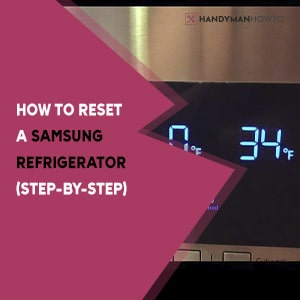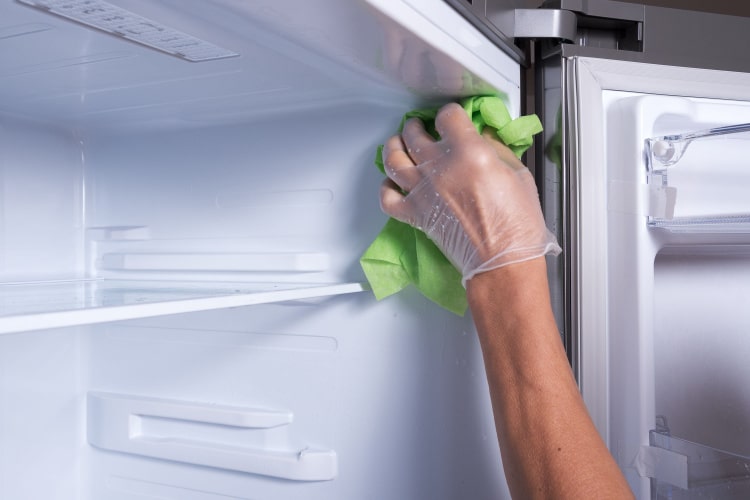Samsung refrigerators are known for their reliability and efficiency. However, they may occasionally need to be reset, just like any other electronic device.
A reset can help resolve issues such as malfunctioning temperature control, error messages, a malfunctioning water dispenser or ice maker, or faults from a power outage.

Whatever the reason, you may wonder how to restore regular operation to your Samsung refrigerator. In this article, we’ll walk you through the process of resetting it. It’s super easy, so let’s get right to it!
When to Reset a Samsung Refrigerator?
You may need to reset a Samsung refrigerator for a variety of reasons, including:
- The temperature display is not displaying the correct temperature, or the fridge is not cooling or freezing correctly
- The control panel isn’t responding to commands or is showing error codes
- The water dispenser is malfunctioning
- The refrigerator has suffered a power outage
- After cleaning or replacing parts on the refrigerator
Resetting a Samsung Refrigerator: A Step-By-Step Guide
If we had to select one household appliance that must always function at peak performance, it would be the refrigerator. Without it, the food stored inside would spoil, causing a huge mess and a safety hazard.
Luckily, resetting your Samsung refrigerator is a straightforward procedure. Follow the instructions below to get it up and running smoothly.
Step 1: Find the Reset Button
On a Samsung refrigerator, the reset option is typically found on the control panel display on the front of the appliance. However, the reset button may be titled differently depending on the model.
Some fridges have a “Reset” button on the control panel or behind the ice bucket.
Other models don’t have a dedicated reset button and perform a reset using a combination of the “Power Cool” and “Power Freeze” buttons found on the display.
Step 2: Hold the Reset Button
Once you’ve located the “Reset” button or the combination of “Power Cool” and “Power Freeze,” click and hold them down for approximately 10 seconds. You will hear a chime or a beep as you do it. The sound is how you’ll know the refrigerator has started the reset.
Step 3: Allow the Refrigerator to Restart
After the beep, the fridge will start to restart. The process may take a few minutes, and the refrigerator may not respond to any commands during this time. Be patient and wait for the restart process to finish.
Step 4: Check if the Reset Was Successful
To ensure the reset was successful, check if the temperature display shows the correct temperature and the display buttons work.
While this concludes the reset procedure, it’s crucial to understand that there are various Samsung models, and the reset process of each may be slightly different.
If you cannot reset your Samsung refrigerator following our steps, consult the user manual, contact Samsung’s customer service for assistance, or try the other methods in the following section.
Performing a Hard Reset on a Samsung Refrigerator
This method has been used for ages and is always effective! It involves cutting off all power to the appliance for at least ten minutes. Often, this is all that’s needed to reset a device once the power has returned.
You can use the hard reset technique to reset your Samsung refrigerator by following these steps:
- Locate the refrigerator’s power cable and unplug it from the electrical outlet
- Wait 10 minutes before reconnecting the refrigerator
- Wait for the fridge to restart and resume regular operation
- Check whether the temperature display and any other features that were not functioning correctly have returned to normal
Routine Maintenance Tips to Keep Your Samsung Refrigerator in Good Condition

Resetting your Samsung refrigerator is an excellent method for optimal performance, but what’s more important is learning how to properly maintain it so you never have to reset it. Plus, routine maintenance extends its lifespan.
Here are some tips to help you maintain your refrigerator:
- Clean the interior of your refrigerator with a solution of warm water and detergent to keep bacteria and odors at bay
- Clean the condenser coils at the back or bottom of the refrigerator with a brush or vacuum cleaner to remove dust and debris. This maintenance step will promote appropriate airflow and cooling of the interior
- Don’t overload the refrigerator with food because it can block the airflow inside the fridge and cause the temperature to fluctuate
- Examine the door seals for signs of damage and clean them with a damp cloth to guarantee a tight seal
- Don’t leave the fridge open for extended periods, as this can cause temperature fluctuations and reduce the refrigerator’s efficiency
Does the Samsung Refrigerator’s Efficiency Depend on the Outlet’s Amperage Rating?
The electrical outlet’s amperage rating has no direct impact on the functionality of a Samsung refrigerator.
However, using an outlet with a lesser amperage rating than the required one for the refrigerator can overload the circuit and overheat the wires, tripping the circuit breaker and damaging the internal compartments of the fridge.
To ensure safe and reliable operation, a 15-amp outlet is ideal for most refrigerators — this is the typical electrical outlet found in most households. However, some refrigerators are more powerful and draw more electricity, so they need a 20-amp outlet.
Additionally, Samsung suggests connecting its refrigerators to a 15-amp or 20-amp outlet with a dedicated circuit. A dedicated circuit is wired to a single electrical outlet to power a single heavy-duty electrical device or appliance and is not shared with any other electrical devices or appliances. This setup ensures that the appliance or device gets a consistent and uninterrupted flow of electricity, which prevents electrical damage.
Conclusion
By properly resetting a Samsung refrigerator, you can quickly fix any issues and ensure your device’s safe and efficient operation.
So let’s sum up. If your Samsung fridge isn’t cooling or freezing correctly, has suffered a power outage, the control panel and water dispenser are malfunctioning, or you’re replacing parts on the refrigerator, resetting it is a must.
Resetting it can be done by pressing either the “Reset” button or a combination of the “Power Cool” and “Power Freeze” buttons.
If this doesn’t fix your issue, you can try the “old school” way, which involves unplugging your refrigerator from the outlet and letting it sit for around 10 minutes before plugging it back into the outlet and restoring its power.
Resetting your refrigerator is vital for resolving any potential problems, but good maintenance may prevent such issues from occurring in the first place.
Clean the inside and condenser coils regularly, never overfill them with food, ensure the doors seal properly, and never leave them open for extended periods.
Lastly, install a 15-amp or 20-amp outlet with a circuit dedicated to your Samsung refrigerator.